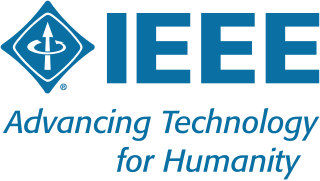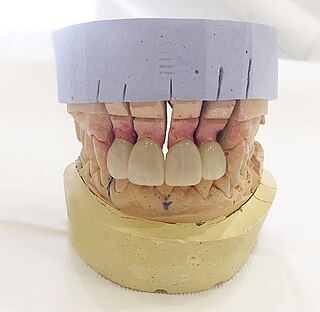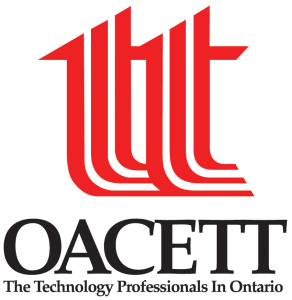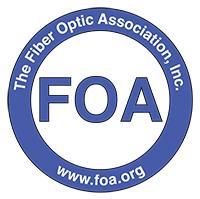Professional certification, trade certification, or professional designation, often called simply certification or qualification, is a designation earned by a person to assure qualification to perform a job or task. Not all certifications that use post-nominal letters are an acknowledgement of educational achievement, or an agency appointed to safeguard the public interest.

The Institute of Electrical and Electronics Engineers (IEEE) is a 501(c)(3) professional association for electronics engineering, electrical engineering, and other related disciplines with its corporate office in New York City and its operations center in Piscataway, New Jersey. The IEEE was formed from the amalgamation of the American Institute of Electrical Engineers and the Institute of Radio Engineers in 1963.

An engineering technologist is a professional trained in certain aspects of development and implementation of a respective area of technology. An education in engineering technology concentrates more on application and less on theory than does an engineering education. Engineering technologists often assist engineers; but after years of experience, they can also become engineers. Like engineers, areas where engineering technologists can work include product design, fabrication, and testing. Engineering technologists sometimes rise to senior management positions in industry or become entrepreneurs.
Aeronautical Radio, Incorporated (ARINC), established in 1929, was a major provider of transport communications and systems engineering solutions for eight industries: aviation, airports, defense, government, healthcare, networks, security, and transportation. ARINC had installed computer data networks in police cars and railroad cars and also maintains the standards for line-replaceable units.
A biomedical engineering/equipment technician/technologist or biomedical engineering/equipment specialist is typically an electro-mechanical technician or technologist who ensures that medical equipment is well-maintained, properly configured, and safely functional. In healthcare environments, BMETs often work with or officiate as a biomedical and/or clinical engineer, since the career field has no legal distinction between engineers and engineering technicians/technologists.

A computer repair technician is a person who repairs and maintains computers and servers. The technician's responsibilities may extend to include building or configuring new hardware, installing and updating software packages, and creating and maintaining computer networks.
Certified engineering technologist (CET) is a Canadian professional certification awarded on the basis of academic qualification and work experience. Abbreviated as C.E.T., most Canadian provincial engineering and applied science technology associations offer this certification. Certification is voluntary and does not represent a provincial regulatory requirement or a statutory required license.

Dental laboratories manufacture or customize a variety of products to assist in the provision of oral health care by a licensed dentist. These products include crowns, bridges, dentures and other dental products. Dental lab technicians follow a prescription from a licensed dentist when manufacturing these items, which include prosthetic devices and therapeutic devices. The FDA regulates these products as medical devices and they are therefore subject to FDA's good manufacturing practice ("GMP") and quality system ("QS") requirements. In most cases, however, they are exempt from manufacturer registration requirements. Some of the most common restorations manufactured include crowns, bridges, dentures, and dental implants. Dental implants is one of the most advanced dental technologies in the field of dentistry.
The general radiotelephone operator license (GROL) is a license granted by the U.S. Federal Communications Commission (FCC) that is required to operate certain radio equipment. It is required for any person who adjusts, maintains, or internally repairs FCC licensed radiotelephone transmitters in the aviation, maritime, and international fixed public radio services. It is also required to operate any compulsorily equipped ship radiotelephone station with more than 1,500 watts of peak envelope power, a voluntarily equipped ship, or an aeronautical station with more than 1,000 watts of peak envelope power. The GROL is not required for engineering jobs in radio and television broadcasting. It is obtained by taking a test demonstrating an adequate knowledge of the technical and legal aspects of safe radio operation.
Association of Public-Safety Communications Officials (APCO) International was founded in 1935. It is the world’s oldest and largest organization of public safety communications professionals and supports the largest U.S. membership base of any public safety association. APCO’s mission is to be a leader in providing public safety communications expertise, professional development, technical assistance, advocacy and outreach to benefit its members and the public.

The Ontario Association of Certified Engineering Technicians and Technologists, or OACETT, is a not-for-profit, self-governing organization in Ontario, Canada. It is a professional association that promotes the interests of engineering and applied science technicians and technologists to industry, educational institutions, government and with the public. It currently has 24,000+ members.

RCC Institute of Technology(RCC) was founded as the Radio College of Canada in 1928, making it one of the oldest private technology institutions in Canada. It is also the only private educational institute in Ontario to be approved by the Ministry of Training, Colleges and Universities to grant bachelor's degrees. In 2018, Yorkville University acquired RCC Institute of Technology. It was amalgamated with Yorkville to become Yorkville University/Ontario.
The Association of Science and Engineering Technology Professionals of Alberta (ASET), is a professional association located in Alberta, Canada. The organization represents applied science and engineering technology professionals in industry, educational institutions, the public and the government. ASET also evaluates the qualifications of individuals who voluntarily apply for certification and issues professional credentials accordingly. It also delivers a number of benefits and services to its members and their employers.
Applied science technologist (AScT) is a Canadian professional certification awarded on the basis of academic qualification and work experience. Abbreviated as A.Sc.T., some, but not all, Canadian provincial engineering and applied science technology associations offer this certification.

Electronic engineering is a sub-discipline of electrical engineering which emerged in the early 20th century and is distinguished by the additional use of active components such as semiconductor devices to amplify and control electric current flow. Previously electrical engineering only used passive devices such as mechanical switches, resistors, inductors, and capacitors.

The United States Navy job rating of electronics technician (ET) is a designation given by the Bureau of Naval Personnel (BUPERS) to enlisted members who satisfactorily complete initial Electronics Technician "A" school training.

The 202nd Engineering Installation Squadron is a unit of the Georgia Air National Guard. The installation, repair and serviceability of sophisticated command, control, communications, intelligence, intelligence, surveillance, and air reconnaissance to Air Force installations worldwide is the responsibility of the men and women of the 202nd Engineering Installation Squadron.
In Canada, a new occupational category of "technologist" was established in the 1960s in conjunction with an emerging system of community colleges and technical institutes. It was designed to effectively bridge the gap between the increasingly theoretical nature of engineering science degrees and the predominantly practical approach of technician and trades programs. Provincial associations may certify individuals as a professional technologist (P.Tech), certified engineering technologist (C.E.T.), registered engineering technologist (R.E.T.), applied science technologist (AScT) or technologue professionel (T.P.). These provincial associations are constituent members of the Canadian Council of Technicians and Technologists (CCTT), which nationally accredits technology programs across Canada through its Canadian Technology Accreditation Board (CTAB). Nationally accredited engineering technology programs range from two to three years in length, depending on province, with two-year programs leading to a C.Tech. certification and three-year programs usually leading to an AScT, CET or RET certification.

The International Certification Accreditation Council (ICAC) is an alliance of organizations dedicated to assuring competency, professional management, and service to the public by encouraging and setting standards for licensing, certification, and credentialing programs.

The Fiber Optic Association (FOA) is an international professional society of fiber optics. The FOA was founded in 1995 by a group of trainers from industry, government and education who wanted to create industry standards for training and certifying fiber optic technicians. The FOA is a not-for-profit 501(c)6 organization based in California, USA, that has over 200 affiliated training organizations in over 40 countries. FOA approves fiber optic training organizations and certifies their instructors who train designers, installers and operators of all types of fiber optic networks. FOA programs are used by many organizations, companies and trade unions to train and certify their workers.











